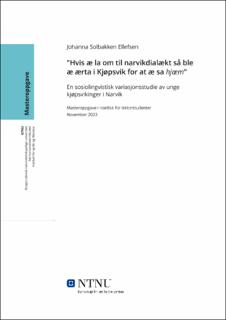| dc.contributor.advisor | | |
| dc.contributor.author | Ellefsen, Johanna Solbakken | |
| dc.date.accessioned | 2024-01-29T18:19:24Z | |
| dc.date.available | 2024-01-29T18:19:24Z | |
| dc.date.issued | 2023 | |
| dc.identifier | no.ntnu:inspera:155667142:23116724 | |
| dc.identifier.uri | https://hdl.handle.net/11250/3114395 | |
| dc.description.abstract | Formålet med denne studien har vært å undersøke språklige forhold blant ungdom fra Kjøpsvik som har flyttet til Narvik. Med språklige forhold mener jeg de faktiske språklige realiseringene, samt holdninger til egen dialekt og dialektvariasjon. Ved hjelp av to hovedinformanter fra Kjøpsvik har jeg prøvd å si noe om språklige forskjeller, språklig tilpasning og hva som kan forklare språkvalgene som ungdommene tar. Jeg har også brukt tre andre informanter fra Kjøpsvik og Narvik for å undersøke ulike forestillinger og oppfatninger av språk blant ungdommene. Her er teorier om identitet, sted og tilhørighet sentrale for drøftingen, samt språkbruk i lys av standardisering og språklig status.
Oppgaven min er dermed todelt, i første del har jeg gjort en språklig analyse av faktisk språkbruk, og i andre del har jeg fortatt en innholdsanalyse av holdningene som ligger bak. Det empiriske datamaterialet er hentet fra tre intervjuer og tre parsamtaler. Jeg har gjennomført kvalitative forskningsintervjuer med informantene mine fra Kjøpsvik, og hver av disse har også deltatt i en parsamtale med informanter fra Narvik der jeg ikke har vært til stede. Tre av informantene mine er oppvokst i Kjøpsvik, og alle informantene er i alderen 16-20 år og bor og går på skole i Narvik. Jeg har i hovedsak benyttet meg av en kvalitativ metode som har gitt en dypere forståelse av informantenes subjektive erfaringer, samtidig som jeg til viss grad har benyttet meg av den kvantitative metoden da jeg undersøkte de språklige realiseringene til to av informantene.
Resultatet viser at det er variasjon blant ungdommenes språklige repertoar, og at dette i høyeste grad påvirkes av identitet og tilhørighet. Ungdommen som bruker tradisjonelle former har stor lokal tilhørighet til bygda Kjøpsvik, mens ungdommen som bruker moderne former har stor tilhørighet til byen Narvik. Språkholdningene og oppfatningene blant ungdommene kan sees i sammenheng med en bredt-fint-dikotomi, som plasserer narvikvarieteten som en slags standard og høyere posisjon i et språklig hierarki. Samlet sett viser informantene noe toleranse for språklig variasjon, men at man uavhengig av varietet helst bør snakke den «rene» og «ekte» dialekten for å høre til. | |
| dc.description.abstract | The purpose of this study has been to explore language aspects among youth from Kjøpsvik who have moved to Narvik. By linguistic aspects I mean the actual linguistic realizations, as well as attitudes towards one's own dialect and dialect variation. With the help of two main informants from Kjøpsvik, I have sought to say something about linguistic differences, linguistic adaptation and what can explain the language choices that these youths make. I have also used three other informants from Kjøpsvik and Narvik to explore different conceptions and perceptions of language among the youths. Here, theories about identity, place and belonging are central dimensions, as well as language use in the light of standardization and linguistic status.
My thesis therefor contains two parts, in the first part I have done a linguistic analysis of actual language use, and in the second part I have done a content analysis of the attitudes behind it. The empirical data material is obtained from three interviews and three pair-conversations. I have accomplished qualitative interviews with my informants from Kjøpsvik, and each of these has also participated in a pair-conversation with informants from Narvik where I have not been present. Three of my informants grew up in Kjøpsvik, and all the informants are aged 16-20 and live and go to school in Narvik. I have mainly used a qualitative method that has given a deeper understanding of the informants' subjective experiences, while at the same time I have made use of the quantitative method to a certain extent when I examined the linguistic realizations of two of the informants.
The results show that there is variation among the young people's linguistic repertoire, and that this is to the greatest extent influenced by identity and belonging. The informant who uses traditional forms has a strong local belonging with Kjøpsvik, while the informant who uses modern forms has a strong belonging with Narvik. The language attitudes and perceptions among the youths can be seen in the context of a broad-fine dichotomy, which places the Narvik variety as a standard and higher position in a linguistic hierarchy. Overall, the informants show some tolerance for linguistic variety, but that regardless of variety, one should preferably speak the "pure" and "genuine" dialect in order to belong. | |
| dc.language | nob | |
| dc.publisher | NTNU | |
| dc.title | "Hvis æ la om til narvikdialækt så ble æ ærta i Kjøpsvik for at æ sa hjæm". En sosiolingvistisk variasjonsstudie av unge kjøpsvikinger i Narvik | |
| dc.type | Master thesis | |
